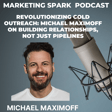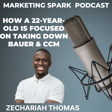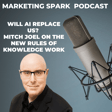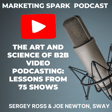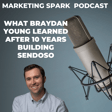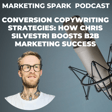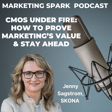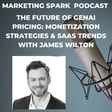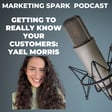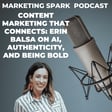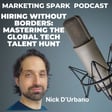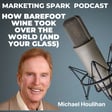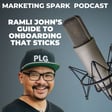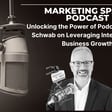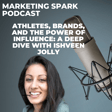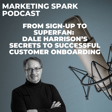Become a Creator today!Start creating today - Share your story with the world!
Start for free
00:00:00
00:00:01

What's a Fractional CMO and How Do They Deliver?
One of the more interesting business trends is the rise of the fractional executive.
It's the idea that you can someone with skills and experience but not on a full-time basis. It's an intriguing model for companies looking to fill gaps economically.
In this episode of Marketing Spark, I sit down with Malcolm Lewis to explore the fractional CMO (FCMO) model.
We look at the definition of FCMO, what they do, how to hire one, and how to define the rules of engagement.
Malcolm also talk about the value of positioning as a pillar of the B2B marketing foundation.
Learn more about how I help B2B SaaS companies with positioning.
Transcript
The Role and Significance of Fractional CMOs
00:00:07
Speaker
Malcolm Lewis and I are kindred spirits. We're both huge advocates for the power of positioning and how it plays a key role, a crucial role, in a company's marketing, sales, customer sex, and product development activities. As well, we have positioned ourselves, no pun intended, as fractional chief marketing officers. A title that sounds sexy, even though a lot of people don't necessarily understand what it involves, assuming they've come across the title at all.
LinkedIn Connection and Collaboration
00:00:37
Speaker
Malcolm and I connected via LinkedIn. It has turned into a collaborative relationship that has allowed us to evolve and change our consulting service offerings and messaging over the past few months. It's a great illustration of the power of LinkedIn to bring people together. Welcome to Marketing Spark, Malcolm.
Defining a Fractional CMO
00:00:55
Speaker
Thank you, Mark. Delighted to be here and appreciate the opportunity.
00:00:59
Speaker
As I said off the top, you and I call ourselves fractional CMOs. So hopefully, we have a good idea of what this entails. How would you describe a fractional CMO to people who haven't come across the concept yet? Yeah, I kind of define it big picture, medium picture, and then some details. So big picture, I just define a fractional CMO as a part-time marketing leader.
00:01:25
Speaker
If we double click on that, this is somebody that can translate business goals, which is typically to grow sales of a particular product or multiple products.
00:01:35
Speaker
by a certain amount, translating those business goals into marketing strategy, marketing goals, and marketing tactics. It's obvious to folks like us, but I sometimes have to explain to CEOs that they're far more likely to actually achieve those business goals if there's a strong marketing strategy and tactical execution plan to support that.
Explaining Marketing Strategy to CEOs
00:01:55
Speaker
Then I drill down on that and I say,
00:01:58
Speaker
The fractional CMO, we're going to do two things. And one has to be done before two. First, we're going to help you create that strategic foundation. We're going to create a clear and compelling customer story for the product that's going to include targeting, positioning, and messaging. But then we're going to help you actually deliver that story to prospects through technical marketing programs and deliverables.
00:02:21
Speaker
Things like websites, email campaigns, paid search, paid social webinars, plus sales support like training and materials so that you can actually get that great story in front of prospects and generate the pipeline and revenue that you're looking for. So that's kind of how I define it. I find that fractional CMO, most folks get the concept of a part-time leader. I actually typically spend more time explaining what marketing is and what marketing does and defining the marketing process.
00:02:51
Speaker
and getting alignment on that than I do explaining what a fractional CMO is.
00:02:56
Speaker
That's a great definition. I took notes during your comments and I'm gonna definitely incorporate them into my positioning and my messaging. That's awesome.
Growth and Challenges of the Fractional CMO Model
00:03:05
Speaker
I decided to call myself a fractional CMO a couple of years ago. I had tried digital marketer, marketing strategist, brand positioning expert, marketing consultant, and none of them seemed to stick. None of them seemed to resonate. And I was struggling to gain some traction to put the spotlight on what I do and I decided to
00:03:26
Speaker
Embrace fractional cmo because it did to me represent marketing leadership both from a strategic and tactical point of view. At the time i thought that fractional cmo the concept would just explode with the rise of people working from home and.
00:03:46
Speaker
contract employees and the idea that the fractional chief financial officer had gained such traction, I thought, well, it's a no-brainer. I'm going to be riding the wave. And to be honest with you, there is momentum, but it's slower than I expected. I would be interested in your take on how this concept
00:04:08
Speaker
is growing. What do you see as the pros and cons of the model? Do you think that people understand what it entails and why it could matter to them? It's a loaded question. I guess what I'm trying to say is I thought this thing would be huge and it's not. It's not as big as I thought and just wondering what your perspective is on that.
Demand and Focus Areas for Fractional CMOs
00:04:28
Speaker
You know, the last part of your question was a little bit about what we talked about before, which is
00:04:35
Speaker
actually setting an expectation as to what marketing is. I think a handful of CEOs, and they're typically in companies that are growing faster, understand the critical role that marketing plays alongside sales and product in actually not only delivering a great product, but delivering a great story that actually compels people to try and buy the product.
00:05:00
Speaker
In terms of the model and momentum, I'm fairly new to this, as you know, from our conversations. I only started earlier this year. I'm definitely seeing enough demand, and the good thing is that folks like you and I, we only need two or three clients at a time to keep ourselves busy. In terms of the title, I definitely noticed that as soon, I also, I played around with positioning coach, messaging coach, product story coach, strategic marketing consultant, marketing consultant,
00:05:30
Speaker
As soon as i started calling myself a fraction of cmo the unsolicited leads. Start coming in so if we went on to google trends i guarantee we would find that the fraction of cmo would get far more. Is getting far more search traffic than all of those other kind of monikers that you and i chose.
Benefits and Risks of Fractional CMOs
00:05:51
Speaker
In terms of pros and cons, obviously the biggest benefit for the company is they get an executive that will actually help them translate business goals into marketing strategy and tactics and actually get the results they're looking for. If you don't have strong marketing, sales suffers from long sales cycles, small deal sizes, lower close rates, customer success is getting slow product adoption.
00:06:18
Speaker
Low engagement, high-term product is probably building features that customers don't want.
00:06:24
Speaker
And a CMO, whether they're full-time or fractional, is there to stop those things happening and fix those problems. Selfishly from our side, and I wasn't quite sure whether this question refers to us or to the customers, from our perspective, I love the variety of working with two or three different clients at the same time. I got one in particular that literally is blowing my mind in terms of some of the stuff that they could be doing.
00:06:50
Speaker
In terms of negatives for a company, by definition, if it's a fractional CMO, you're not getting 100% of their time and focus. The marketing results, pipeline, and revenue are definitely not going to be as strong.
00:07:06
Speaker
as they would be if you had a dedicated full-time CMO, somebody that's constantly working with sales, constantly working with success, constantly working with the demand gen team to make sure the story is as strong as it can possibly be, and that it's being delivered through tactical programs, through sales, without anything getting lost.
00:07:27
Speaker
in translation. So that's the biggest negative for companies. I think the second negative is a part-time fractional CMO is far more likely to move on. And so as a CEO, you risk losing not only that leadership, but all of that company knowledge and expertise that was in the head of the fractional CMO. That's kind of how I see it. Does that resonate with how you're seeing it?
00:07:52
Speaker
A statement and a question. Okay. The statement is that I think the fractional CMO model is very sexy. And as you and I have discovered, it's like bees to honey. It's very attractive because it sounds good. It sounds like this is somebody who's experienced who can bring marketing leadership.
00:08:12
Speaker
And I think from a marketing perspective for marketers, it's a very good concept to embrace. The statement is I think a lot of people who are just marketing consultants are embracing the fractional title. So I think there's going to be some confusion in the marketplace among customers because they're going to have a tougher time figuring out, is this somebody who's experienced and knows what they're doing or is it just somebody who's trying to ride the wave? So that's the statement.
00:08:34
Speaker
The question would be, and I grapple with this on a regular basis, and this is something I've been thinking about a lot recently, is whether a fractional CMO can effectively lead a company's marketing forward. So follow me here. As a marketer, as a marketing leader, you have to be drinking the Kool-Aid 24-7. The CEO wants you to have your hands on the lever at all times and know
00:08:55
Speaker
What's going on? They want you to connect with multiple stakeholders. They essentially, if you're going to be responsible for leads and sales, if you're going to be a revenue based or revenue driven marketer, then you really need to be driving the car, if not all the time on a regular basis.
Strategy vs. Execution in Marketing
00:09:12
Speaker
So is it possible for a fractional CMO to actually do an effective job when they're not working all the time and leading and drinking the Kool-Aid on a regular basis?
00:09:21
Speaker
I think it is possible and I think it depends on whether or not there are some existing marketing resources in the company, whether it's marketing sales or other disciplines.
00:09:36
Speaker
There's strategy, which sets goals, sets objectives, sets metrics, creates dashboards, and measures progress. And then there's actually doing the work. And there's work to be done on both the strategic side and the technical side. On the strategic side, there's customer research. There's market research. There's competitive research to be done. There are exercises you can go through to identify
00:10:03
Speaker
your unique positioning, that intersection of something that you do exceptionally well that customers really want, that competitors don't do. There's work to be done and templates and processes that you can go through to develop your messaging. And likewise, on the execution side, there's folks that know how to run email campaigns, know how to set up and run paid search, paid social.
00:10:27
Speaker
I think the only way a fractional CMO can work is if the CEO understands that there's a separation between strategy and execution, oversight and execution.
00:10:39
Speaker
and is willing to either hire or rent the resources necessary to actually do the work. You're definitely not going to hire a fractional CMO and have them become a one-person marketing team that's going to magically do everything that a traditional
00:10:58
Speaker
You know, even in a small company, three, four, five person marketing team in a large company, you know, there's a hundred plus folks that are doing all those different things that I just mentioned. The key is, is separating what you should be doing and getting the work done.
00:11:14
Speaker
And as somebody that's hiring a fractional CMO, being prepared to either hire or rent some of the resources required to take advantage of the expertise of the CMO and actually do the work. And of course, the CMO is then going to help you review the work and guide the work and even help produce the work. But they're not doing all of that work all of the time because then they're not fractional. They wouldn't have time
00:11:43
Speaker
to do it for more than one client. I like the fact that you raise the issue that some companies expect a fractional CMO to strategize and also do the work because I run into situations where they've paid me a monthly retainer to be their fractional CMO and provide marketing leadership. And then when push comes to shove,
00:12:04
Speaker
when it comes to tactical execution, they turn to you and they say, well, we're paying you really well. You should do tactical execution as well. And that's a problem that I run into on a regular basis because I agree with you is that a fractional CMO thrives when there's marketing firepower that they can leverage. There's people who can actually do the work and a fractional CMO can provide this strategic guidance. They can review, they can brainstorm, they can ideate, but ultimately you don't want a fractional CMO to do the work.
00:12:31
Speaker
you have specialists who are great email people or content or SEM people. And that's a one plus one equals three kind of proposition. Related to that is the question or the reality, like given the current economic conditions, do you think the fractional CMO model will be more enthusiastically embraced by budget conscious companies?
00:12:56
Speaker
And the one caveat or the wild card that comes to mind amidst times when marketing budgets are being scrutinized is whether people actually want to pay for strategy. My take is that there's a huge desperation for leads. Strategy seems to be taking a secondary role because it's all about tactics, tactics, tactics. Get leads in the door so we can close some deals. What are your thoughts on whether the fractional model
Fractional CMO Model for Budget-Conscious Companies
00:13:23
Speaker
Is it more attractive right now, just as attractive, less attractive? How do you see the market? It's hard for me to give a broad assessment, but there's a good steady trickle of interest coming to me. For me, it's a qualifying question. Do you believe that strong tactical execution, that strong pipeline and strong revenue
00:13:49
Speaker
is predicated on a really strong customer story. Do you believe that until you've developed and tested and validated with customers, your product positioning and messaging, do you believe that that's the necessary prerequisite to actually generate quality leads at scale? And if they don't believe that, and you can easily, it's very easy to ask that question and look them in the eye and figure out if they believe that.
00:14:17
Speaker
Um, if they don't, I actually, I just move on. That's right. That's, that's a losing battle for people like you and I, because both you and I, you know, CMO is coming to flavors. You're, you're either, you're either a black belt and strategy.
00:14:29
Speaker
and you're really good at targeting, positioning, and messaging, and good at translating that into go-to-market, or you're a tactical go-to-market specialist. Either a broad specialist, or you've got particular expertise in paid search, or paid social, or whatever it is. The budget-conscious CEO typically does just want leads, and they just don't understand that there's some work to be done to get those leads, and if you don't do that work, you're gonna get garbage leads.
00:14:57
Speaker
I try and educate those folks and if we get alignment, we've got to do some work up front. And by the way, it doesn't have to take forever to do that work, to actually test and validate the existing story and tweak it if necessary.
Strategic Guidance vs. Tactical Execution
00:15:10
Speaker
But if folks don't want to do that, I actually just walk away because that's not a situation where you and I can be successful.
00:15:19
Speaker
Did I answer all of your questions there? Let me know if I didn't. Yeah, you answered all the questions. There's a lot to think about when it comes to the relationship or the nature of the engagement between a company and a fractional CMO. When a company is looking to hire a fractional CMO,
00:15:35
Speaker
What do you think they need to consider given that marketers come in different shapes, sizes, skills, and experiences? As you noted, there are some fractional CMOs that are black belts in strategy. There are some that are black belts in tactical execution. I tend to fall on strategy side because I lean into positioning messaging and go to market planning. I think you're in the same boat as well. So if I was looking for a fractional CMO,
00:16:03
Speaker
What are some of the key considerations so that I can find someone who is going to be a partner, is going to help me be successful and ultimately it's going to be a win-win proposition? So I think there's a couple of ways to think about it. One, and I find this, when I talk to CEOs, they either say we've got a story problem or they say we've got a lead problem. If they say they've got a story problem, I know that they need
00:16:31
Speaker
a fraction of CMO like me that has that strategic background where we specialize in crafting, testing, and delivering the story and working with demand gen to get that story delivered properly. If they say they've got a lead problem, then they're probably going to be more interested in a CMO that's got a strong demand gen background. And if you think that you've got a rock solid story,
00:16:58
Speaker
and you think you've got a lead problem, then you should hire a fractional CMO that's basically a former head of demand gen that's calling themselves a fractional CMO. If you've got some doubt that your story is fully fleshed out, if you've never tested it and validated it, if you've got all the symptoms of a weak story that you and I have talked about, weak engagement and conversion on ads,
00:17:25
Speaker
weak traffic, weak conversion on the website, long sales cycles, small deal sizes. Everyone's asking for a discount, high churn, long onboarding times. Those are all symptoms of a story that needs work. But it boils down to what the CEO believes. If they think the story's solid and they're still getting subpar pipeline and revenue, then it's a solid story that's not being delivered properly through good demand-gen execution. Go hire a demand-gen expert.
00:17:55
Speaker
If you've got any doubt that the story is part of the issue, then I would recommend that you start
Onboarding and Delivering Quick Wins
00:18:00
Speaker
with a CMO that has a strong storytelling background because it's a lot easier to nail the story and then hire or rent the execution folks to deliver that story. Most guys like us can tell you how to do that execution and help you hire or rent those folks. Very few demand gen people are very good.
00:18:23
Speaker
at nailing the story. They're just two kind of mostly mutually exclusive skill sets. One's very strategic, one's very tactical. So, net-net, very long answer. The short version is if you think you've got a rock-solid story and you think your problem is leads, hire somebody with a demand-gen background. If you think you've got a story problem, hire somebody with a strategic product marketing background.
00:18:51
Speaker
So if I came to you as a B2B SaaS company and I said, Malcolm, I love your experience. I love what you have to say on LinkedIn. I have a lead problem. Would it be fair to say that you would answer them by saying, I'm not the right person for you. You need somebody who is a demand gen expert. I can help you with your story, but if you don't think you have a story problem, then I'm not the person you should hire. Would that be something that you would, you would rally around?
00:19:18
Speaker
Well, I wouldn't be that blunt, right? I'd say, are you sure you've got a lead problem? Let's talk about some of your marketing and sales metrics, right? Let's look at
00:19:31
Speaker
sales cycle times. Let's look at deal sizes. Let's look at how many deals you win and lose. Let's look at how many people ask for a discount. Let's look at some of the website metrics. Let's look at some of your demand gen metrics. Are you open to the idea that you might actually have a story problem that has to be fixed before you can generate more leads and certainly before you can generate quality leads that will convert to sales. And as you've seen and heard me say many, many times,
00:20:01
Speaker
I refer to lead gen, demand gen as a downstream function from story creation and development and validation. And I call those downstream functions garbage in, garbage out. I'll explore that with the CEO and I'll ask them questions around those metrics and see if a light bulb goes off and they say, you know what, you're right. I think we do have a story problem.
00:20:28
Speaker
Or at least we have an opportunity to fix the story, and if we fix the story, refine the story, level it up, call it what you like, if we can improve that story, then de facto we'll like, even if we change nothing on the demand gen side, and nothing on the sales enablement side, just by percolating that improved story through those two functions, we're more likely
00:20:51
Speaker
to get what we're looking for, which ultimately is more qualified sales opportunities through demand gen and more of those opportunities converted to sales through sales plus marketing sales enablement.
00:21:05
Speaker
Once a fractional CMO was hired, how did they launch an engagement on the right foot? What are the keys to establishing a successful partnership? And I'd be interested in learning more about your onboarding methodologies, the conversations that you have with the CEO after they make the decision to hire you, how you align your capabilities with their expectations so that when
00:21:29
Speaker
You start an engagement. Everything's aligned. Both sides know what's going to happen, what needs to happen, so that there's not a disconnect. And I find in my practice, if you don't have that alignment and there's a disconnect, then
00:21:44
Speaker
It happens pretty quickly. Things are not happening the way both sides expect. Unhappiness and disappointment come into the mix and the engagement goes pear-shaped pretty quickly. So what's your approach? What are your thoughts in making sure that when you hire a fractional CMO and they're always excited when they hire a fractional CMO because it's a marketing leader, someone new and fresh and exciting, they're going to do amazing things. But how do you carry the momentum on? How do you turn the concept and the excitement into reality? Yeah, you know, it's funny because I've actually
00:22:13
Speaker
got better at doing this as I've started to do it. And honestly, I didn't do the best job I think in my first few engagements.
00:22:21
Speaker
But what I've learned and the process I have now is essentially there's three elements to it. And you used the word a little bit earlier, right? At the end of the day, anything in life, disappointment comes from misset expectations. So it's all about setting expectations. And I kind of do that in three ways. First of all, I get alignment on the process.
00:22:44
Speaker
and I get alignment on the priorities, right? So I get sales buy-in and obviously CEO buy-in that we must at least test and validate the story and get that right before we can fix or scale demand gen and sales enablement. So one, get alignment on the process and priorities.
00:23:04
Speaker
Two, we want a scoreboard, right? People want to see progress, so let's make that tangible by defining the process milestones and metrics, right? So for example, let's agree and let's baseline customer feedback on the current story. Let's take the landing page and let's just review it with a handful of customers or customer properties or prospects and just find out what percentage of them love it
00:23:32
Speaker
and would love to learn more about the product versus what percentage would not. And then let's fix the story, create a new landing page, go through that process again, and retest that metric after we've updated the story. Similarly, let's baseline pipeline and revenue. Let's baseline some leading indicators like engagement rates, conversion rates, win rates, sales cycles, all that good stuff. Again, let's baseline that before we start making changes.
00:24:00
Speaker
And then let's measure them on an ongoing basis after we make some changes. And then third, so that's how we can measure success. Let's agree on how we're going to measure success. Let's baseline what we're doing before I start. And then let's look at the positive, hopefully the positive impact on those important metrics after we start to work our magic.
00:24:23
Speaker
And then the third is people are impatient, right? Head of sales, CEO, everyone wants to see some quick wins. I think you can get some quick wins early in the process. First of all, you don't have to take months to rework the customer's story. Talk to a bunch of customers, understand why they buy, the problems you're solving for them.
00:24:44
Speaker
the specific use case, the key metric that needs to be moved up and to the right. Make sure that you're talking to the subset of customers that love the product, NPS score 9 or 10. The folks that say they'd be severely disappointed we took the product out of their hands.
00:25:00
Speaker
You can do that kind of research in a few weeks, quickly update the story and then start running those landing page tests and provide real data to the CEO and the head of sales that the new story works better than the old story. You haven't done anything yet in terms of rolling it out to demand gen programs and updating all of the sales training tools and materials, but you've already got to win because you've already proven
00:25:29
Speaker
that customers like the new story more than the old story, then you can start to bake the new story into some very high profile, tangible points of presence, which is typically the website and a sales deck. Then make sure it flows through to all external points of presence. So if you're on G2 and Captera.
00:25:50
Speaker
Make sure that the company LinkedIn profile page is updated. Make sure that all the employee pages on LinkedIn are updated so that everything is consistent with that story. Then you can start working with demand gen, bake the new story.
00:26:05
Speaker
into their programs, and we should see improved engagement and conversion on the demand gen stuff. Bake the story into the sales training, into the sales deck, and we should start to see some improvements on sales metrics like shorter sales cycles, bigger deal sizes, fewer discounts, and so on.
00:26:22
Speaker
So get alignment on the process. Number one, process and priorities. Number two, define milestones and metrics for that process. And then three, deliver quick wins where some of those wins can be delivered way in advance of making changes to demand, gen and sales enablement.
00:26:46
Speaker
And honestly, I'm kind of learning this as I go along, Mark. It's in terms of how I do it as a consultant versus how I do it as the in-house head of marketing.
Strategies for Quick Wins and Engagement
00:26:57
Speaker
So this is kind of my latest snapshot of how I think about it and how I position it. Yeah, I like the fact that you mentioned impatience because one of the
00:27:07
Speaker
problems with being a fractional CMO is you're often seen as the silver bullet, as the magical elixir that's going to change marketing and going to revive leads in sales. And one of the realities or one of the things that I run into on a regular basis is that if they hire you as a fractional CMO, and we're not as expensive of a full-time CMO, but you do pay a healthy retainer to have a fractional CMO.
00:27:31
Speaker
The first few months, you're establishing that foundation. You're trying to build a customer store. You're doing research and trying to get as much insight as intelligence that you can. And it takes time to get up to speed. And yes, you can have some quick wins. You can update the website. You can tweak the sales deck. But it may take you two or three months to actually find your stride and really start to move the ball tactically.
00:27:56
Speaker
By that time, the CEO is looking at the spreadsheets or their expenses and going, what am I getting from the fractional CMO? Because they really haven't produced something tangible. Again, it goes back to their fascination with leads or their obsession with leads. The question would be, how does a fractional CMO quantify their success in the short and long term?
00:28:17
Speaker
Given that a lot of what we're doing over the first three to six months may be a lot of block and tackling the fact that it's not sexy, it's not going to generate fantastic results, but it's necessary grunt work that needs to happen so that you establish that great foundation so that really excellent marketing can happen.
00:28:37
Speaker
But I think the first thing that I've learned is you can't take two to three months to fix the story. You've got to time box it. You've got to make it four, six, eight weeks and do the absolute best you can in that timeframe and move on. Because people don't have the patience to wait three to four months for you to refresh the story. And quite honestly, you can get 90, 95% of the improvement
00:29:03
Speaker
very, very quickly, especially if they have happy customers. The quickest tactic that I've found to get points on the board is to help a company transition from selling product benefits. Companies think they're ahead of the game when they're selling product benefits over product features. But actually, if you've got happy customers,
00:29:29
Speaker
The silver bullet is case studies. If you've got case studies, nobody believes a vendor, even when they make grandiose product promises around benefits versus features. But if you've got customer case studies, the last company I was at, I had the above the fold, the entire right half.
00:29:50
Speaker
of the above the fold area on the website was just rotating case studies. And they were just images that with a headline on the case study and there was about 20 of them and you could click on any one of them and go to a landing page to describe the problem, the solution and the benefits.
00:30:06
Speaker
we did the same thing with email. Instead of just pushing out cold email drips that are talking about the problems we solve and why we're the best way to solve them, we just pushed out case studies because the case study is the shortcut. It shortcuts the prospect's brain to, these guys have something I want because
00:30:30
Speaker
The only folks visiting your website and the only people you should be pushing this case study content to are people like those customers that you've already delivered for. Instead of getting an email or looking at an ad where somebody's promising to revolutionize X or transform Y, it's a company that looks just like me that solved a problem, just like the one I'm trying to solve.
00:30:55
Speaker
and got up into the right improvement in just the metric I'm looking to improve, now I'm interested in the company behind this story. I'm interested in the product behind it. Talking to customers, talking to those kind of super happy customers is the fast track to dialing in the story. And I think you can do it in six to eight weeks, not three to four months. And two, you can immediately start pushing those
00:31:21
Speaker
through demand gen and making sure the sales deck starts. Everybody puts customer success stories at the end of the sales deck. Put it at the beginning. Give people a reason to listen to the next 20 minutes. Don't tell them about the company on the first slide. Certainly don't tell them about the product. Start with three or four customer case studies and then people will pay attention if those case studies are relevant to what they're trying to do.
00:31:46
Speaker
Again, that's a very long-minute answer. If I net it out, you can shortcut the story optimization process by really... And this only works for companies that have a lot of happy customers or at least a dozen or more. You can get that down to four to six weeks, maybe even less if you really put a lot of time into it. That's much better than three to four months.
00:32:08
Speaker
and set that expectation up front, right? It's going to take six weeks. I've got to talk to half a dozen customers. I've got to talk to your head of sales. I've got to talk to your number one sales rep. I've got to talk to the head of customer success. I've got to talk to your number one customer success rep. And I've got to distill all that down. But in four to six weeks, I can give you a new customer story that I think will probably work better. And in the meantime, I want you to start running
00:32:33
Speaker
Customer case studies at the top of your website and if you're running drip campaigns, I want you to replace Emails that are talking about product benefits with emails that showcase customer success That's great insight and I'll tell you two hacks two quick win hacks that I use when it comes to new clients One is obviously I try to get the customer story done as quickly as possible but I will
00:32:59
Speaker
Talk to customers, ask to talk to customers. And it's always interesting when a CEO says, whoa, really? You want to talk to our customers? They try to protect them or even hide them. So I'll talk to customer and I'll say to the CEO, listen, I think it's important that I talk to them independently because.
00:33:14
Speaker
the customer will be more open to what they think and feel. It's not on the record, it's not gonna be used for marketing, it's gonna be used for customer intelligence. And I'll go back to the CEO and say, guess what I learned? They said this, this, this, they would like this, this, this, and they're unhappy about all these things. And the CEO, it's mind blowing in many cases, because they don't talk to customers and they don't get that insight. I can do a little bit of legwork and deliver some really good insight. The other thing that I've actually found
00:33:41
Speaker
Before you go to the other thing, I want to really double click strongly on what you just said. So the very first engagement I did, I used Grain and I recorded all the customer interviews that I did and Grain would transcribe them and I shared them with the CEO and the head of sales and I got the exact same reaction you got. Oh my goodness, I had no idea that people had an issue with that or that people really liked that.
00:34:11
Speaker
And because they don't, because the head of sales and the CEO don't talk to customers and because you and I are very good at asking all the right questions, not only about their experience with the product and what they love and what they don't love, what they love about the company, what they don't love. The problem that the straw that broke the camel's back that actually triggered the buying process in the first place, where they were looking, how they were evaluating.
00:34:36
Speaker
different vendors, why they chose you, why they have stayed with you, and asking these questions and exposing both the good news and the bad news. If there's one thing you could change about the product, what would it be? If there's one thing you could add to the product, what would it be? Rate our customer service one to five stars. If it's not five stars, tell me why. Rate the product ease of use one to five. If it's not five, tell me why not.
00:35:02
Speaker
And that just produces so many insights that obviously you and I are going to use to bake into a new story. But you share those videos with the CEOs and they're like sharing it all over the company. To your point, it is mind blowing to them and it's mind blowing to us that they've never done it before.
00:35:19
Speaker
And it's great, as you said, you can double down on it because it gives you the insight you need to move forward with developing the customer story. The other hack that I have, and it sounds kind of old school, is a customer newsletter. So I'll ask a company, do you send a customer newsletter? And some of them do. It's either monthly or quarterly, and you look at the newsletter, it's completely uninspiring. There's no storytelling.
00:35:40
Speaker
It's all about product, product, product. It has nothing to do with the customer. So what I'll do is I'll come up with a very simple template for a customer newsletter. Here's what's going on with their product. Here's some inspiring work done by customers just like you. Here's some of the events we're going to. And I'll give them a lot of different things to look at and to read.
00:36:02
Speaker
And I did this with a client recently, and we got tremendous feedback. And there are two quick benefits here or two really great benefits here. One is it engages the customer and shows them that you care. It delivers insight and advice and guidance. And a lot of customers feel abandoned by many companies once they come in the door.
00:36:21
Speaker
company rarely engages with them. They don't educate, they don't excite, they don't inspire. So even a boring vehicle like a newsletter can generate some good reactions and good feedback and some good upsell opportunities. And I think that's why it can be a very good quick win. I completely agree. And not only is it informative in terms of his
00:36:41
Speaker
Here's product enhancements, here's new features, here's where you can find us if you happen to be going to any of these trade shows. But by sharing wins, you're helping your existing customers feel good that other companies like them are also continuing to choose you. And so it reinforces the fact that they made a good decision by choosing you. Nobody wants to be sold and then
00:37:06
Speaker
As far as they know, nobody else ever bought the product, right? If you can constantly share other customer wins and to your point, throw in some of the other information around how the product is being continually improved and enhanced to make it even more valuable and more valuable money for them and where they can find you, how they can engage with you. If you can solicit their feedback as part of that process, then yeah. And it's funny because everything that you and I have talked about, it all comes back to the customer. It all comes back to.
00:37:36
Speaker
building a stronger bi-directional relationship with the customer. If there's a silver bullet in market and in B2B business, it's the customer and in particular happy customers because not all customers are equal. We're going to have some customers that maybe shouldn't have bought our product in the first place. They don't like it. They don't use it for whatever reason. We don't necessarily want their feedback.
00:38:06
Speaker
What we want is the feedback from the subset of customers that just love the product. They tell people about the product. They provide testimonials, case studies. They provide great feedback on how the product can evolve. And the silver bullet in B2B business, not just marketing, because it helps sales, product, and success, is to open up that channel and keep information flowing back and forth.
00:38:33
Speaker
We spend a lot of time talking about the customer story and the fractional CMO model.
The Evolving Role of Positioning
00:38:39
Speaker
The other area that we need to discuss is positioning, which is part of the customer story. The idea that being crystal clear on what you do, who you serve, why, what you do matters to the people that you serve and how your unique, different, or better underpins marketing, sales, customer success, and product development.
00:39:02
Speaker
And I am an advocate, a wildly enthusiastic advocate for positioning. And sometimes I feel like I'm Don Quixote, tilting against windmills. I'm running up a hill madly, but not getting anywhere when it comes to getting people to recognize that positioning is a need to have, not a nice to have.
00:39:23
Speaker
I'm curious about your take on position. I know you're a fan as well. I know it's a key part of how you operate, but whether you think that positioning gets short shrift, whether it's one of these marketing
00:39:35
Speaker
Vehicles that a lot of companies. Yeah, it's business important, but they don't pay enough attention to it Especially now when there's so many competitive options and demand is soft that if you don't stand out You're not gonna do very well interested in your thoughts on on positioning and and how you get companies to buy into the idea that positioning matters Yeah, and
00:39:58
Speaker
I think the easiest way, I find the easiest way to do that is just to make it very tangible. I think positioning sounds like this abstract, theoretical marketing construct. But as soon as you start asking people, last time you were in the grocery store and you're wandering down the aisles, why did you choose a particular product?
00:40:18
Speaker
Why did you use a product that you've never needed before? And when you were looking at the two or three brands there, why did you pick a particular brand? At the end of the day, customers need to know why should they even change the way they're working today? So you've got to essentially sell your category. There's a better way to do what you're doing. There's a better way to move.
00:40:40
Speaker
you know, trial conversion rates from X percent to Y percent. And it's this new way you haven't thought about. And by the way, we're the best at doing that and proving that you are the best at doing that. And so you've got to give reason, you've got to give people, whether it's buying consumer products in the grocery store or whether it's, it's, it's a human being that's trying to decide if they need a new product.
00:41:02
Speaker
And if they do need a new product, which product to choose, because there seems to be half a dozen similar products, you've got to answer very clearly, very concisely, why should they pick you? Why are you the obvious choice for that particular use case, for that particular industry?
00:41:20
Speaker
And that's what positioning does. And it's no different than what car manufacturers do to make you choose their SUV versus somebody else's or their sports car versus somebody else's. And it's no different from what CPG companies are doing as you walk down the aisle and they're trying to get you to pick their toothpaste. I think the key is you've got to make it tangible. You've got to make it relatable and make it clear to them
00:41:48
Speaker
that if people A, don't consider them and then B, don't choose them, all the money that they've invested in product marketing and sales and support is all for naught because you got to make people want
00:42:02
Speaker
to try and buy your product. Positioning is how you convince people to want to try and buy your product. If you don't give them a clear reason, they're not going to do it. I go to a lot of people's website, there's a ton of information about why you should
00:42:19
Speaker
why you should need a CRM, why you need email, why you need a learning management system. The people that are going to your website probably already know why they need a learning management system or an email marketing solution or a CRM. They're not there for you to confirm why they need a product in that category. They're there to figure out if you're the best in that category for their particular needs.
00:42:48
Speaker
And that's what you've got to do with positioning is you've got to say, if you need a product in this category, we're the best fit for you and your use case for these clear, understandable reasons. And by the way, here's all the customer proof points to prove that I really am the best in this category for what you need and your particular use case.
00:43:14
Speaker
I think one of the challenges with positioning comes down to deliverables.
00:43:19
Speaker
You can create brand positioning statements, value propositions, strategic narratives, a lot of things that are frankly used internally as a blueprint or guidance. And I think CEO will look at a positioning exercise and go, well, I'm paying you for this. Is that all I get? And the one thing that I did want to stress is during a position engagement, you're talking to customers, you're talking to key stakeholders, you're doing a lot of industry research. One of the.
00:43:46
Speaker
The key deliverables in my mind is the discussions that you have with the senior leadership team and the questions that you ask and the issues that you raise and the things that you make them think about. And to me, that is there's such huge ROI in doing that. I'm going to give you an example of I was working with a company that's involved in property management for condos and they had a story problem.
00:44:08
Speaker
We went through the process and we talked to customers. I must've talked to 10 other customers and had series of means with the chief revenue officer and the CEO. And the CRO said to me, you know, I've already started to change my sales deck and what I say to customers. I went to a conference and I tried our new story just as a trial run and it resonated. And I can already see the value of this exercise. And to me, I'm getting tremendous ROI already. And I hadn't even done
00:44:35
Speaker
any of the templates, completed some of the templates that we as marketers like to roll out. I think it's important for people to realize that even the exercise of positioning is so valuable as you go through the process and that you take different approaches and different perspectives to get your story right.
00:44:52
Speaker
From positioning, it lends itself completely into storytelling and messaging. Is that, as you said earlier, you can tell your story on social media and G2 and Captera and all those awesome places. I personally think the ROI of positioning is massive. If only people would recognize that that is the reality of the exercise. Yeah. And positioning is not an input to the story. It's the headline to the story, right? Positioning is the headline to the story. We're the best.
00:45:21
Speaker
for solving this problem or addressing this business need or delivering this business impact for these companies, perhaps in this industry, right? You can niche down by use case and industry, but you need to be either the best at any price or the best at an affordable price. None of us buy second best in anything, right? We don't buy second best pair of socks. We don't buy the second best of anything.
00:45:49
Speaker
But we modify what's, quote, best based on our needs, our use case, and what we think is a reasonable cost. And so to me, position is just the headline of the story. It's the headline on your website. It's expanded by the subhead on your website. It's the title slide on the sales deck. And it's the elevator pitch that the sales reps use at trade shows when they pick up the phone and they talk to people. And you're right, you can very quickly
00:46:18
Speaker
document the evolving positioning just in a couple of sentences, a headline and a subhead, and have people start testing it and see what the feedback is. And then I do, as I mentioned before, I like a process where you literally just bake a headline, a subhead, a graphic, three reasons why, three value drivers, three reasons to choose us, put it on a landing page,
00:46:44
Speaker
do it for the old positioning and the old story, do it for the new one, and just measure what percentage of people like it, let them score the new story versus the old story. Because when you're talking to the CEO and you're talking to sales, what you don't want is positioning to be a marketing deliverable.
00:47:03
Speaker
This is me giving something to you with no supporting evidence. It needs to be, here's what we've developed together. I spoke to you. I spoke to your top performing sales reps. I spoke to the head of customer service. I spoke to all the best customer service reps. I spoke to all your happiest customers. We collaborated on this story. The story is not owned by marketing. The development and delivery of the story is owned by marketing.
00:47:32
Speaker
But the story is owned, co-owned by the CEO, marketing, sales, success, and product. The one thing that I'll add to our positioning
00:47:45
Speaker
narrative is the idea that positioning is fluid and dynamic. I was listening to a podcast between Chris Walker, a very well-known B2B marketer, and the head of a company called Bravado, which offers, they help companies hire salespeople. During the B2B SaaS boom in the last couple of years, this company saw explosive growth, went from zero to $6 million in revenue in one year, 2021. The economic landscape changed.
00:48:15
Speaker
high tech companies in particular stopped hiring 20 to 50 sales reps a quarter and went to two to five. This company's revenue projections for 2022 plummeted by 75% in two months. Suddenly the idea of offering a white glove premium service didn't resonate anymore. And the company had to pivot its product and its messaging. And the messaging was really interesting as the CEO explained, it went from
00:48:42
Speaker
We can hire help you hire aggressively and quickly to, we can help you replace the 10 to 20% of your salespeople who are underperforming. We'll swap them out. We'll bring in all these other really great salespeople and we'll help you improve your sales. And I thought that was a really interesting illustration of how. Positioning is not a set it and forget it kind of proposition. It's something that evolves over time. And, and as a marketing leader, how do you know when your position needs to change?
00:49:07
Speaker
That's easy when the primary existential metric of your buyer changes. At the end of the day, you're positioning your product as the best product to achieve a particular impact on the business for the decision maker and the buyer. Using your example, they thought back then that biggest problem was hiring good people quickly and efficiently.
00:49:34
Speaker
Now they think their biggest problem is basically getting rid of the deadwood and back filling with quality replacements. Positioning is always a reflection of your customer's most pressing business need that you are uniquely qualified to solve. And if their perception of the problem they're trying to solve or the business impact they're trying to achieve changes,
00:50:01
Speaker
then you've got to recast your positioning because all you're doing is positioning no pun intended or pun intended. You're positioning your product as the best solution to this really big problem or this really urgent business need that you have.
00:50:19
Speaker
And if your business need, your business priorities change, then I need to make sure that I still position my product as the best way for you to achieve that. By definition, if the most pressing problem that you can solve for your customers changes over time, then your story changes because you're referencing a different problem. The only thing that changed in your example was the problem they referenced. They still said, we're the best way for you to do X.
00:50:46
Speaker
where X was the problem, it's just that the problem changed from hiring good people quickly to getting rid of dead wood and backfilling with good wood.
Conclusion: Strategic Importance of Fractional CMOs
00:50:57
Speaker
This has been a great conversation, although I have to admit you broke a cardinal rule from my podcast. I advertise the fact that this is a 30-minute conversation, that it's perfect for walking your dog, and that it's more like a light meal as opposed to a five-course meal. But you and I have spent the last 56 minutes talking about fractional CMO, customer storytelling, and positioning. It's a great conversation. It's a conversation I love happening because I think
00:51:23
Speaker
All of it is super important and I hope that people see the value in what we're advocating. You and I live in a very customer story strategy of world as opposed to tactical education and brute blunt force. And I think it's really important for people to appreciate that. Marketing is a mix of things. Some things have to happen in the short term. Some things are underpin what you do for the short and long term.
00:51:46
Speaker
And that's what makes for successful marketing. So I really appreciate your insight. One final question for you is, where can people learn more about you and what you do? That's easy. Malcolmluis.com. The only tricky part of that is no one can spell Malcolm. So it's M-A-L-C-O-L-M. So two L's. Everybody misses the second L. L-E-W-I-S at gmail.com. And of course, they can see you on LinkedIn. You're very active there in terms of writing content and commenting in other people's posts.
00:52:16
Speaker
I am. And you know, it's interesting. I don't get a lot of engagement because I'm fairly new to LinkedIn, but I do it because I, A, I love the process of posting something because it forces me to think of a particular topic and try and boil it down. And as marketers, that's part of our job, right? Is to take complex ideas and make them simple. And two, if I was looking for somebody to hire, I'd want to see examples of their thought process and their thinking.
00:52:43
Speaker
I'm fairly new to aggressively posting content on LinkedIn, but I'm on there and I do post stuff. Currently doesn't get as much love as I'd like it to get, but I love the process. And for anyone that is thinking about working with me, take a look at some of that content and you'll get a very good idea for my thought process. And you'll like it or you won't. At least you'll get the opportunity to make a decision.
00:53:04
Speaker
Well, thanks Malcolm for the great conversation and thanks to everyone for listening to another episode of Marketing Spark. If you enjoyed the conversation, leave a review, subscribe via Apple Podcasts, Spotify, or your favorite podcast app, and of course share via social media. To learn more about how I work with B2B SaaS companies as a fractional CMO and strategic advisor, and positioning a messaging consultant, email bark at barkevans.ca or connect with me on LinkedIn. I'll talk to you soon.

